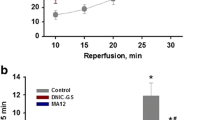Abstract
In experiments on rats we studied the effects of cardioplegic solutions with L-aspartic acid or L-arginine on functional recovery and metabolism of isolated working heart after 40-min normothermal global ischemia and 30-min reperfusion. After reperfusion of the hearts preventively protected with cardioplegic solution containing L-aspartic acid or Larginine, coronary flow decreased in comparison with the initial values. As a component of cardioplegic solution, L-arginine was less efficient in recovery of contractility and cardiac output of the hearts in comparison with L-aspartic acid. In hearts protected with L-aspartic acid, the postischemic levels of ATP and phosphocreatine were significantly higher, and the level of lactate was significantly lower than in hearts protected with Larginine. In comparison with L-arginine, L-aspartic acid is a more efficient component of cardioplegic solution in protection of the heart from metabolic and functional damages caused by global ischemia and reperfusion.
Similar content being viewed by others
References
O. I. Pisarenko, V. S. Shul’zhenko, I. M. Studneva, and A. A. Timoshin, Kardiologiya, 44, No. 4, 65–70 (2004).
M. R. Adams, W. Jessup, and D. Hailstones, Circulation, 95, 662–668 (1997).
M. Carrier, M. Pellerin, P.L. Page et al., Ann. Thorac. Surg., 66, 108–112 (1998).
N. Hayashida, H. Tomoeda, and T. Oda, Ann. Thorac. Cardiovasc. Surg., 6, 27–33 (2000).
J. R. Lancaster, J. E. Hibbs, Proc. Nat. Acad. Sci., 87, 1223–1227 (1990).
P. F. Mery, S. M. Lohmann, and U. Walter, Ibid., 88, 1197–1201 (1991).
H.U. Bergmeyer (Ed.), Methods of Enzymatic Analysis, New York (1974), pp. 1565–1569, 1772–1781, 2101–2110.
O. I. Pisarenko, F. L. Rosenfeldt, L. Langley et al., Ann. Thorac. Surg., 59, 1541–1548 (1995).
H. Taegtmeyer and T. Doenst, in: Ischemia-Reperfusion Injury in Cardiac Surgery, Georgetown (2001), pp. 79–89.
K. Takeuchi, F. X. McGowan, H. C. Danh, et al., J. Mol. Cell. Cardiol., 27, 1405–1414 (1995).
J. Vinten-Johansen and R. S. Ronson, in: Ischemia-Reperfusion Injury in Cardiac Surgery, Georgetown (2001), pp. 2–27.
Author information
Authors and Affiliations
Corresponding author
Additional information
__________
Translated from Byulleten’ Eksperimental’noi Biologii i Meditsiny, Vol. 141, No. 4, pp. 392–396, April, 2006
Rights and permissions
About this article
Cite this article
Pisarenko, O.I., Shul’zhenko, V.S. & Studneva, I.M. Efficiency of cardioplegic solutions containing L-arginine and L-aspartic acid. Bull Exp Biol Med 141, 410–413 (2006). https://doi.org/10.1007/s10517-006-0185-1
Received:
Issue Date:
DOI: https://doi.org/10.1007/s10517-006-0185-1




